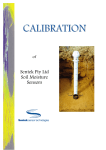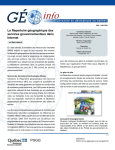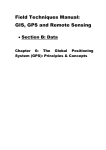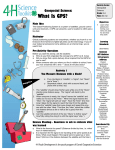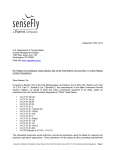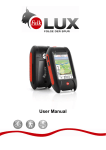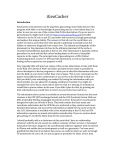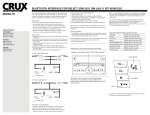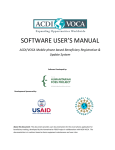Download PDF - EDIS - University of Florida
Transcript
ENY-728 An Introduction to GPS1 Jorge R. Rey2 GPS (Global Positioning System) is a navigation system composed of a flotilla of satellites put into orbit by the Department of Defense, and their ground stations. With GPS, one can automatically determine the precise location (latitude and longitude) at any point on earth using a ground device that picks up signals from multiple satellites. It works continuously in any part of the world and is available to anyone free of charge. With origins in secret military applications, GPS is now part of everyday life. Dedicated receivers are small and inexpensive, and GPS technology is now found in airplanes, boats, automobiles, cell phones, personal digital assistants, and many other common products. History of GPS GPS originated from the need of the armed forces for precise navigation systems that could be used in a variety of applications. Development of GPS technology rests on advancements in physics, electronics, materials science, and many others, but it was the development of extremely accurate time-keeping devices - atomic clocks, together with advancements in space technology - that really made GPS possible. Accurate time-keeping is essential because GPS relies on timing of signals from satellites to ground receivers to determine position, and the signal travel times are very short (see below). Accurate time keeping - All atoms emit electromagnetic waves of a characteristic and highly precise frequency when they switch energy states due to rearrangement of their electrons. These waves are known as resonant frequencies. In 1944, I. I. Rabi, winner of that year’s Nobel Prize for his development of the magnetic resonance technique to measure the resonant frequencies of atoms, suggested that because of the precision of atomic resonances, they could be used to create extraordinarily accurate clocks. In 1948, the National Bureau of Standards (NBS) in the USA built the world’s first atomic clock. It used molecules of ammonia, and the beam tube was a copper pipe wrapped around the clock face. It was never used for timekeeping because it was less reliable than quartz clocks, with an error of about one second in four months. The first functional atomic clock was built in 1955 and occupied a complete room at the National Physics Laboratory, UK. It used resonant frequencies of cesium atoms and was accurate to within 1 second in 300 years. In 1956, a portable version, the “Atomichron” that could be easily moved from one place to another was developed. Other versions of the atomic clock soon followed using resonant frequencies from atoms such as cesium and rubidium, and the hydrogen maser, which used hydrogen atoms and ammonia molecules. The rubidium-based clocks 1. This document is ENY-728, one of a series of the Entomology and Nematology Department, Florida Cooperative Extension Service, Institute of Food and Agricultural Sciences, University of Florida. Original publication date April 2006. Revised June 2009. Reviewed July 2012. Visit the EDIS website at http://edis.ifas.ufl.edu. 2. Jorge R. Rey, professor, Entomology and Nematology Department, Florida Medical Entomology Laboratory, Vero Beach, Cooperative Extension Service, Institute of Food and Agricultural Sciences. University of Florida, Gainesville, FL 32611. The use of trade names in this publication is solely for the purpose of providing specific information. UF/IFAS does not guarantee or warranty the products named, and references to them in this publication do not signify our approval to the exclusion of other products of suitable composition. The Institute of Food and Agricultural Sciences (IFAS) is an Equal Opportunity Institution authorized to provide research, educational information and other services only to individuals and institutions that function with non-discrimination with respect to race, creed, color, religion, age, disability, sex, sexual orientation, marital status, national origin, political opinions or affiliations. U.S. Department of Agriculture, Cooperative Extension Service, University of Florida, IFAS, Florida A&M University Cooperative Extension Program, and Boards of County Commissioners Cooperating. Thomas A. Obreza, Interim Dean are smaller and less expensive than the cesium clocks, but they are not quite as accurate. In 1967, the second was officially redefined in terms of the oscillations of the cesium atom (1 second = the duration of 9,192,631,770 cesium-133 cycles).The primary time standard in the United States is the NIST-7 atomic clock at the National Institute of Standards and Technology in Boulder, Colorado, with an estimated accuracy of 1 second in 3 million years! Advancements in technology continue to allow for development of smaller and cheaper atomic clocks (Figure 1). Figure 1. Dr. John Kim with the ultra-miniature Rubidium atomic clock. Credits: Office of Naval Research The Space Age - The seed for satellite-based navigation system was really planted almost concurrently with the start of the Space Age. When the Soviets launched the first earth-orbiting satellite, the Sputnik I, in 1957, researchers at the Johns Hopkins Applied Physics Laboratory in Baltimore discovered that since they knew exactly where they were on the globe, they could determine the exact location of the satellite by measuring the shifts in the frequency of the radio signal being transmitted by Sputnik as it approached and moved away from them. This shift in frequencies, know as the Doppler effect or Doppler shift, had been known since 1842, when Christian Doppler proposed that the frequency of waves in motion relative to an observer apparently increases as the source of the waves approaches the observer and decreases as it moves away. It was only a small intuitive leap to figure out that the opposite was also true; that one could similarly determine one’s position on earth if the exact position of the satellite was known. submarines that could stay submerged for weeks and even months at a time. It consisted of six satellites in polar orbits. Position was determined using the Doppler shift, where the satellites transmited a signal that provided the time of transmission and orbital information to a receiving unit which then computed its position using the signal frequency shifts and the time and positional information corresponding to the signal with no Doppler shift. The system could determine 2-dimensional position to within 25 meters and it took the submarines six to 10 minutes to get a fix. Throughout the 60s, various branches of the armed forces worked on their own versions of satellite navigation systems. In 1973, the Department of Defense directed the services to cooperate on development of a unified system. The result was the Navstar Global Positioning System, which relied on satellites that carried atomic clocks (a concept that was tested on an earlier Navy program called “Timation”), ground stations that controlled the system, and user receivers that did not rely on atomic clocks. The first GPS satellite was launched in 1978. Starting in 1989, a second generation of navigation satellites (“Block II satellites”) was put into service. The system became fully operational in 1995. Today’s GPS satellite flotilla consists of at least 24 Block II satellites (Figure 2). In 1983, after the Soviets shot down a Korean civilian airliner that intruded into Soviet Union airspace because of navigational errors, Ronald Reagan announced that the GPS system would be made available for civilian uses once it was completed. Figure 2. Artist rendering of a NAVSAT satellite. Credits: NASA In 1965, the US Navy developed the Transit system, in response to the need of an accurate guiding system for 2 Because the GPS system was developed primarily as a military application, timing errors (selective availability, SA) were applied to GPS transmissions that limited the accuracy of non-military receivers. During the Persian Gulf War in 1991, GPS had become so essential that not enough military receivers were available for the troops, so the Department of Defense had to use civilian units and temporarily remove SA. Global SA was eliminated in the year 2000, but the US military can still introduce inaccuracies in the signals over defined geographic areas. How Does GPS Work? GPS depends on each satellite on the constellation to transmit its exact location and an extremely accurate time to receivers on earth. With this information, GPS receivers can calculate the distance from the satellite, and by combining this information from four different satellites, the receiver can calculate its exact position by a process knows as trilateration. Trilateration - Once you know the distance to one satellite, you know that you are located on a sphere centered on the satellite with a radius equal to your distance to the satellite (Figure 3A). represents an absurd location, such as far out in space, or a point that is moving at an impossible velocity, and can be rejected without measuring. The fourth measurement, however, is still needed as explained below. The fourth satellite - Distance to the satellites is determined by measuring the amount of time that it takes a radio signal from the satellite to reach the receiver (Distance = velocity X time). Because radio signals travel at the speed of light (186,000 miles per second) the travel times are extremely short, thus you need an extremely precise timing device to measure it accurately, hence the need for atomic clocks on the satellites. However, the receivers do not have atomic clocks so there will be measurement errors on that side of the system and even small timing error can results in large position error. Here is where the fourth measurement comes in. If all measurements are accurate, the sphere defined by the fourth measurement should intersect the other three spheres at a point representing our true location. If there are errors, however, the four sphere will not intersect all other spheres. Because the receiver error will be the same for all four measurements, a computer in the receiver can calculate the correction needed to make all four spheres intersect and then apply that correction to the measurements to determine the true position. A fourth measurement also allows the system to compute a three-dimensional position that includes not only latitude and longitude, but also elevation. Elevation measurements, however, are referenced to a mathematical model of the earth so that they can be expressed in relation to a conventional datum (usually mean sea level). This model is only an approximation so the elevation readings are usually less accurate than the latitude and longitude readings, and the errors are different at different locations around the globe. Figure 3. Determining position from 3 satellites. Credits: Jim Newman With similar information from a second satellite, the position is narrowed to the area held in common by the two spheres (shaded area, Figure 3B). Adding information from a third satellite further narrows down the position to the two points were the three spheres intersect (small squares, Figure 3C). To determine which point represents our exact location we can make a fourth measurement, but usually one of the two points obtained from three satellites Other errors - Other errors enter into the GPS signal measurements, these include atmospheric interference and reflection from ground obstacles such as buildings and trees. Several techniques such as dual frequency correction, signal filters, and mathematical modeling are used to minimize these errors. Increased accuracy - Techniques are constantly being developed to make GPS systems even more accurate and reliable. The most widely used at this time are differential GPS (DGPS) and Wide Area Augmentation System (WAAS). DGPS basically uses land based stations, whose locations are exactly known, to receive GPS signals, apply corrections (since they know exactly were they are, they can 3 determine the errors from the GPS signals) and broadcast them so that properly equipped receivers can use them to correct their own signals. WAAS is a secondary satellite system developed by the Federal Aviation Administration that not only transmits GPS signals, but also monitors and reports the status of GPS satellites, and transmits differential GPS information. The system is available only over North America and the Pacific Ocean. Most GPS units available today are capable of accuracies of 10 meters or less. Use of advanced techniques such as the ones mentioned above can bring accuracies down to a meter or less. Specialized applications which employ sophisticated data manipulation techniques and high end equipment can achieve accuracies measured in centimeters. Uses of GPS The development of accurate and reasonably priced GPS receivers (Figure 4), and the continuous miniaturization of electronic components have made GPS available to almost everyone, and GPS is rapidly becoming a necessity in many aspects of everyday life. intensity of planting, application of fertilizer and pesticides, watering schedules and many others. These systems can also help farmers keep track of their farm operations by maintaining records of yields, chemical application history, soil analysis results, profit/loss records by field, and many more. Modern applications of GPS technology in agriculture also include positioning and operation of robotic farm equipment in the field. For more information on uses of GPS in agriculture and precision agriculture consult: http:// deathstar.rutgers.edu/projects/gps/web_page/web_page. html Land and Sea Navigation - In addition to direct uses of GPS for determining exact position and for plotting courses with in-vehicle navigation systems, GPS is being used to improve the accuracy of nautical charts, for driving auto-pilot systems, for marking underwater objects such as dangerous obstructions or that favorite fishing hole, and for determining exact positions of ships at sea. Emergency agencies now rely heavily on GPS to improve response times, and delivery and shipping companies use GPS systems to keep track of their vehicles more efficiently, schedule pick-ups and deliveries, and maintain detailed operational and maintenance records. GPS is also used to track property, such as motor vehicles, and for roadside assistance systems such as OnStar. Military - In addition to the more mundane applications such as general navigation, GPS is used in the military for a wide variety of applications, including targeting missiles and “smart bombs,” force deployment, field coordination and many others. Mapping and Surveying - GPS has allowed the creation of more accurate maps and charts, and is used routinely by surveyors to map projects and to locate survey markers, structures, boundaries, and natural features. Figure 4. Accurate and reasonably priced GPS receivers are now generally available. Listing all applications of GPS technology is an impossible task. Below are just a few examples of current day GPS applications. GPS in Agriculture - Satellite navigation is helping farmers and agribusiness to become more productive and efficient in their farming practices. Tractor-based GPS systems together with sophisticated geographic information systems (GIS) use a variety of techniques to gather data such as soil condition, humidity, temperature and other variables, which the system then uses to control things such as Science - The applications of GPS in science are numerous. GPS is particularly useful to field researchers for mapping and locating sampling stations, for defining habitat boundaries, for spatial analysis of natural features, for tracking populations and many others. GPS is also used widely in seismology, physics, space sciences and in many other fields. Recreation - GPS is used by boaters to track courses and find favorite locations, by campers, hikers, and bikers to track their positions and paths and by travel clubs to share trip information and directions. A recent development is the game called “geocaching,” which is, basically, a GPSguided scavenger hunt. Players use GPS to travel to specific 4 geographic coordinates and find objects hidden by other geocachers. Time reference - GPS is often used as a source of accurate time. For example GPS may be used to synchronize multiple scientific recording instruments deployed in the field or for experiments requiring precise timing. GPS based timing is also being used for synchronizing cellular phone towers, telecommunications networks, and many others. GPS timing was used at the Olympic Games for the first time in the 2000 games. Receiver Set-up In most cases, the average user will employ GPS to pinpoint their exact location, follow directions to a desired point, determine the distance and direction to a desired destination, determine altitude, automatically mark a traveled route so that it can be retraced, mark points of interest along a route, show general direction of desired travel, or use it as a traditional compass. pages with detailed instructions and suggestions for use of their units. Below are some of the initial steps necessary to operate a GPS receiver. User information - Set-up of your receiver starts with entry of your personal information such as name and address (in case unit is lost), and of general information and settings such as the local date, fonts to use, brightness of display, computer interface, etc. Display settings - Modern GPS receivers can display a wealth of information and most give you options on what information to display on a given screen (Figure 6). Learn how to change these display settings so that you can always access the information you need. In addition to giving you geographic information, many reasonably priced GPS receivers today can give you a graphical map display with an overlay of your position, tracks, and destination (Figure 5). However, in many cases you need to purchase the terrain data (map) for your particular location separately. Figure 6. Learn how to access all receiver’s data screens and how to modify the data display. Figure 5. Terrain overlays are available for many receivers. Operation of GPS receivers varies widely depending upon the type of receiver and the particular task at hand. Detailed instructions are found in each unit’s user manual and should be studied carefully before use. Most major GPS receiver manufacturers maintain informational web Select a map datum - A map datum is a reference surface, which is defined mathematically and approximates the shape of the earth in particular areas and is used to calculate the coordinates on any map, chart, or survey system. Another way to look at it is that a map datum is a mathematical formula for translating coordinates in a flat map to the actual shape of the earth and vice-versa. In North America, the most common datums are the NAD27, NAD83, and WGS83. WGS83 is rapidly becoming the worldwide standard, and for North America, it is practically identical to NAD83 for most common applications. The NAD27 datum has been replaced by the newer and more accurate NAD83, but you may still find some old maps based on the NAD27 datum. 5 If you are working with a printed map, make sure that your GPS unit is set to the same datum as the map (which should have the information printed somewhere). Also, if you are following waypoints or navigating to given coordinates make sure that your GPS receiver is using the same datum. Many modern GPS receivers will automatically convert locations stored in the unit or added by the user to the correct map datum coordinate system when the datum is changed in system set-up. the unit is acquiring satellites, the display usually shows a circular “chart of the sky” showing the satellites that are available at that particular location and time, and a bar graph showing which satellites you are receiving and the signal “strength” of each (Figure 8). This screen can be accessed at any time to check on the receiver’s communication status. Select a coordinate system - Your GPS can report position information in two major ways, lat-lon and UTM. Lat-lon is the familiar latitude and longitude and is reported in degrees minutes seconds north or south (latitude) and east or west (longitude), for example, 33°12’ 29”N, 80° 23’ 59”E (or as decimal minutes, 33°12.4833’N, 80°23.9833’W). UTM stands for Universal Transverse Mercator. In this system, the world is divided into 60 equal zones from west to east starting at the180° meridian, and position is described in kilometers east from the start of each zone (easting) and away from the equator (northing). In the northern hemisphere, the northing is the distance from the equator, whereas south of the equator, the northing is the distance from the South Pole. You must know which hemisphere and zone you are in to interpret your location globally. UTM coordinates will appear as a series of numbers starting with the zone number, then the easting and then the northing (Figure 7). Figure 8. Screen showing available satellites and their reception by the receiver. The first time a unit is used or if it is moved to widely different geographic locations, the process can be made more efficient by giving the GPS unit an initial calibration, which is basically a hint to the receiver of the general area in which it is located. Figure 7. Typical display of UTM coordinates (without the text labels). In the example in Figure 7 the indicated location is 558 kilometers and 365 meters east of the start of zone 17 and 3053 kilometers and 311 meters north of the equator. Most modern maps will have 1-km UTM grid overlays, which simplify locating UTM coordinates on maps. Acquire satellites - The first step in the actual operation of a GPS receiver is to turn the unit on and let it find (acquire) at least four satellites Once this is done, the unit “knows” its exact location and is ready for work. While Have a backup - Never rely completely on a GPS unit for navigation in unknown areas. As all electronic/mechanical devices, GPS units can malfunction (one very common “malfunction” is running out of batteries, so always carry spare batteries with your unit). In some areas, such as under a heavy tree canopy, reception may be bad so you must rely on other means, such as a map and compass, until you can re-acquire reception. Conclusion Satellite navigation technology has evolved from one with strictly military applications to a common tool used throughout the globe. With advances in GPS technology, falling prices, and simpler human interfaces, we can expect GPS to continue to make inroads into many aspects of 6 every day life where accurate position information is relevant. Additional Web Resources Geospatial Resource Portal - Global Positioning System http://www.geospatialworld.net. Grant F. Walton Center for Remote Sensing and Spatial Analysis - http://deathstar.rutgers.edu/projects/gps/ web_page/web_page.html. Lowrance, What is GPS? - http://www.lowrance.com/en/ Support/Tips-and-Tutorials/GPS-Tutorial. Map Tools - http://www.maptools.com/FreeTools/UTMtools.html. OnStar Technology - http://www.onstar.com/web/portal/ home. 7







